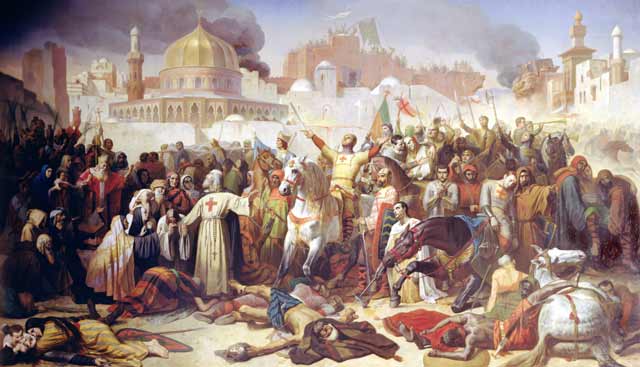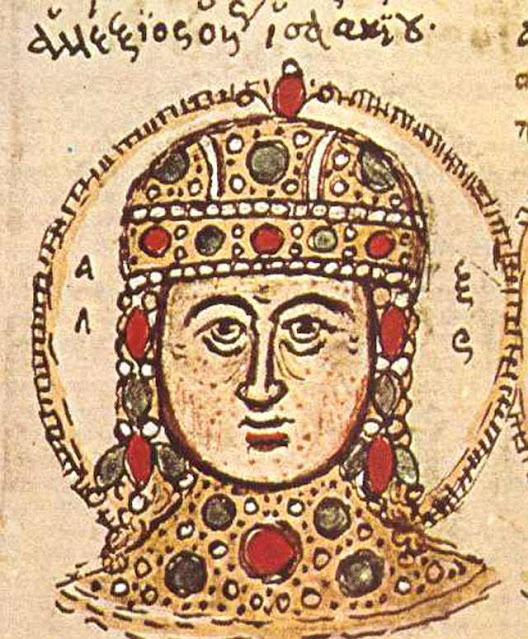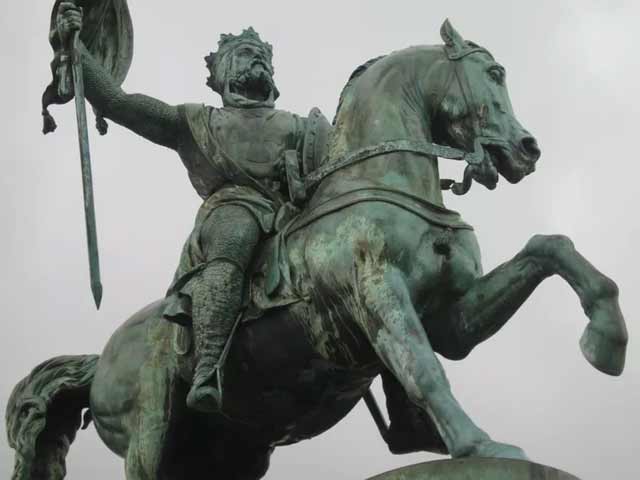Prelude to the Downfall of Byzantium
What was the effect of the Crusades on Byzantium? The Crusades had a huge impact on the Byzantine Empire even though it was a Christian state. You might think that the Byzantines thus had little to fear from the Crusades due to the fact that all Crusaders took an oath not to attack fellow Christians, but this was not the case. What resulted was a great tragedy that benefited a few adventurers, hurt many, and led to the downfall of Byzantium.
First, to set the stage, what were these Crusades? They were military expeditions to the Middle East styled as religious efforts to "recover" the Holy Land (which the Latins had never possessed unless you go back to the days before the formation of the Eastern Roman Empire). There were numerous Crusades and nine to the Holy Land. The First Crusade was in 1099 and the final official Crusade to the Holy Land was in 1271. However, there also were expeditions known as Crusades as late as 1444. Their effectiveness decreased with time. Most of the Crusades had extremely limited impact on Byzantium except for a couple, the First and Fourth.
 |
| As can be seen in this map of the first four Crusades, all land routes to the Middle East were long and arduous, and they all ran through Constantinople (upper right). |
The Effect of the First Crusade on Byzantium
The overall effect of the Crusades on the Byzantine Empire was highly destructive, though they got off to a fairly good start. The first few Crusades arguably were beneficial. Byzantine Emperor Alexius Comnenus instigated them by sending legates to a "church council" at Piacenza who subtly made the case for helping out the Byzantines from the threat from the East after the disaster at Manzikert in 1071. This was the spark that led to all the Crusades that followed and is an excellent example of how the road to Hell is paved with good intentions.
The problems between Crusaders and Byzantium began with the First Crusade and got worse with each succeeding one. The Latins viewed the Byzantines as unreliable allies, and the perception became the reality because the western European armies were none too polite as they rolled through the Byzantine territory. They took what they needed and occasionally even occupied Byzantine cities. By the time the Crusaders got to Constantinople, there had been pitched battles between the Crusaders and the Byzantines that were only ironed over through strenuous diplomacy based on a common goal. Emperor Alexius got his "allies" across the strait into enemy territory as quickly as he could, thereby preventing further problems, but according to his daughter, he was unhappy they had ever entered his kingdom.
Despite all the problems, things worked out reasonably well during the First Crusade for both Byzantium and the Latins. Crusaders were skilled fighters using advanced equipment and scored many victories that the Byzantines were unable to match. The Byzantines regained some cities that the Crusader assault captured when the Latins voluntarily (per agreement) handed them over. This helped to maintain good relations with the Crusaders as long as they were actually fighting the enemy. The Crusading armies distracted the Turkish forces that had swallowed large chunks of Byzantine territory over the past 500 years. The Byzantines ultimately proved too weak to hold on to these territories for long, but for a while, there was a brief Renaissance of Byzantine influence.
The Effect of Subsequent Crusades on Byzantium
The problems between the Crusaders and the Byzantines increased with the next two Crusades, in 1049 and 1089. The Byzantines by this time really didn't want any help from the Latins, having seen the high price it carried, but the Crusades had taken on a life of their own. They were seen by many in Western Europe as a way to gain kingdoms and wealth, particularly by younger sons or brothers of kings who had small armed forces of their own but really wanted their own kingdoms. However, the Byzantines were not on board with these objectives, and rumors began to swirl in Western circles that Emperor Manuel I Comnenus (grandson of Alexius) actually tried to join forces with the Saracens (the medieval term for Muslims) to drive the Crusaders back. During the Third Crusade, the reigning Emperor, Isaac II, also apparently tried to make an alliance with the Saracens against the Crusaders. Once again, there were pitched battles between Byzantine and Crusader forces as the undisciplined Crusaders rampaged through the Byzantine lands en route to the Levant. The Crusaders got through, but there were a lot of hurt feelings and much ill will.
The Crusaders, experiencing reverses in the Holy Land such as the loss of Jerusalem in 1187, also began blaming a supposed lack of Byzantine help (although the Byzantines by and large upheld their agreements) for their own military failings. Furthermore, the Great Schism between the Roman Catholic Church and the Eastern Orthodox Church that had begun in 1054 was widening all the time, and the Crusaders increasingly took a cynical view of their "friends in the East" despite the very real help they offered (such as transporting them by ship into Asia Minor).
 |
| A possible portrait of Saladin made during his lifetime. It was found in a work by Ismail al-Jazari (1136-1206) published circa 1185. |
While there were many factors at play, the fundamental change in why the Crusades turned against Byzantium was that they lost their pan-European religious character and increasingly became single-nation expeditions. There was little enthusiasm in 1202, when the Fourth Crusade began, for new Crusades in most western countries after the loss of Jerusalem and the failure of Richard the Lionheart to recapture it. Generally, one Crusade per generation was quite enough. Due to military exhaustion, the peace treaty that Richard negotiated with Saladin in 1192 began to look like a pretty good deal to many warriors now wary of fighting the surprisingly tough "infidel" for fun and profit.
 |
| A painting by Francesco Hayez (1791-1882) of the First Crusaders at the walls of Jerusalem in 1099. (Royal Palace of Turin, Italy) |
The Disastrous Effect of the Fourth Crusade on Byzantium
So, trying to recapture Jerusalem was out for the time being. That had been done and access to the city for pilgrims assured by a treaty. Unfortunately for bloodthirsty Crusaders, there weren't a whole lot of other worthwhile targets. Only European adventurers with idle hands and their men at arms wanted to "take up the Cross." A half-hearted plan to attack Egypt never amounted to anything, but that didn't stop the Crusaders. They boarded Venetian transport ships on a cash-and-carry basis (the Venetians were not interested in religious boondoggles) and then had to admit they couldn't pay for their passage. The Venetians, now with ships full of armed warriors who were completely at their mercy and who had to do their bidding to ever see home again, saw little profit in Egypt. They did, however, have a huge vested interest in trade routes flowing through Byzantium. Seeing their opportunity, the Venetians adroitly convinced (or coerced) the Franks into attacking the "easy" target of Constantinople in order to satisfy some unpaid bills. The Venetians who wanted to destroy Byzantium took the Franks, who had no quarrel with the Byzantines, to Constantinople instead of Egypt and waited for events to unfold.
The Franks and Venetians used the usual pretext for invasions during the Middle Ages of finding a pretender to the Byzantine throne. This enabled them to claim the moral high ground, as they were simply "dispensing justice" by capturing the city in order to install the "rightful claimant" on his throne. This plan quickly fell apart, though, when the Byzantines, who were no dummies, simply said, "Okay!" and installed the pretender on the throne without giving up their city. This was extremely shrewd politics, one might even say Byzantine in both senses of the word, but not at all what the Crusaders (mostly the Venetians) really wanted. It settled nothing as far as the Crusaders were concerned because they couldn't have cared less which Byzantine ran Byzantium, they wanted it for themselves.
After that, the veneer of legitimacy completely disappeared. The Venetians still wanted the city (and its trade routes), and it didn't matter what the Franks wanted because they weren't going anywhere without the Venetian ships. The Crusaders grudgingly set up camp outside the city and awaited a "provocation." We all know how that works, where an intimidating figure "gets in your face," annoys you, and just waits for you to start a fight you have no hope of winning. An incident came along soon enough as the city's inhabitants roughly treated some high-handed Crusaders visiting a local market (it was not at all unusual for Crusaders from any of the first four Crusades to be arrogant and dismissive in their dealings with the Byzantine locals, not paying for goods and so forth). To this was added the fact that the new (Crusader-supported) Emperor also couldn't fulfill his fanciful financial promises to the Crusaders (he was promptly replaced by the Byzantines when he proved of no use in getting rid of them). The Crusaders were "insulted" and this called for a reckoning, just as the Venetians had hoped all along.
Now with a new "justification" for attacking a nation that had done them no harm, the Crusaders bided their time. The Franks and Venetians "got all their ducks in a row" by dividing the Empire up between them, and finally attacked Constantinople in a coordinated assault. The Franks took the city on the second attempt by using the tall Venetian ships to get over the sea walls that had frustrated so many previous attackers. In the final analysis, advancing ship design finally robbed the fabled Constantinople walls of their defensive power. This was inevitable at some point, and within a couple of hundred years at most the land walls also became obsolete. Without the invulnerability of the old Roman walls, Byzantium was just another ephemeral Middle Eastern power.
 |
| A somewhat more accurate depiction of the fall of Constantinople showing Crusaders scaling the sea walls to gain a foothold in the city. |
The loss of Constantinople was catastrophic for the Byzantine Empire. It was somewhat akin to what would happen if a foreign power somehow occupied London and then held it for decades. All of Byzantine life flowed through and from the capital city. The Byzantines regrouped in separate camps both in Anatolia and in Epirus to the west, but the aura of Byzantine power was shattered forever. They also lost one of the prime advantages of holding Constantinople, its position astride the main trade routes from the East that filled the state coffers with taxes and duties. Without Constantinople, the Byzantines could not control access to the Black Sea, and now the Venetians could sail through without hindrance. It was a boon to Venice that turned it from a moderately successful trading city into the dominant sea power in the eastern Mediterranean. Basically, the Fourth Crusade reversed the fortunes of Venice and Byzantium.
The Fourth Crusade of 1204 thus began the true decline of the Byzantine State. The Crusaders, frustrated at lack of success against the Turks, took Constantinople instead despite the fact that it was a Christian city (they already had taken the Christian port of Zara and been excommunicated for doing so, thereby robbing the expedition of any true religious character). The Fourth Crusade thereby lost all focus and just turned into a band of amoral soldiers of fortune out for personal gain. It was a great betrayal of the original purpose of the Crusade and, though the Byzantines eventually recovered their capital in 1261, the Byzantine State never was the same.
 |
| The Crusaders built the Church of Saint Anne in Jerusalem ca. 1140 while Jerusalem was the capital of the Kingdom of Jerusalem, one of the Crusader States. |
Events After the Fourth Crusade
Some later Crusades were attempted during this period, but the Western powers were now wary of Byzantium. Siding with the Byzantines would be seen as a slap at fellow Latin pretenders to the Byzantine throne, and Crusaders were not interested in supporting their former numbers who had taken Constantinople, either (and trying to help them at all likely would turn into a permanent affair). There was no profit in that. The entire region became a political quagmire. In any event, the former leaders of the Crusades, aside from some individuals (usually French kings) trying to make a religious statement or pursuing imperialistic goals, basically lost interest. The Western powers never again mustered sufficient strength to make a real effort until it was their own kingdoms (such as at the two battles of Vienna) at risk.
 |
| Roger de Flor arrives in Constantinople, by José Moreno Carbonero (1858-1942). |
As the Byzantine world shrank in the 14th and 15th Centuries, it became a staple of Byzantine government policy to try to get the Crusaders to come back and fight off the Turks. The Byzantines made all sorts of extravagant concessions to do this, such as legally "granting" the old Roman province of Britain, which the Byzantines somehow figured they still owned, to its current rulers. The Western nations, however, never did more than pay this idea lip service. Future Crusades simply bypassed Constantinople altogether as Western navies improved and armies no longer had to make the long march overland. Some Western paid adventurers such as Italian mercenary Roger de Flore of the Great Catalan Company arrived to "help" Byzantium. However, they weren’t Crusaders at all and had taken no oath (for what that was worth). The Byzantine Emperor Andronicus II welcomed them anyway because he was increasingly desperate for any aid against the advancing Saracens. These soldiers of fortune did more harm than good to Byzantium but certainly hurt both sides as they grabbed whatever booty they could find. It didn’t help that the Byzantines had problems paying these mercenaries as promised, so there are two sides to that story.
 |
| A reasonably accurate depiction of the fall of Constantinople to the Ottoman Empire in 1453. |
Conclusion
While the Byzantines under Michael VIII did recapture Constantinople in 1261, the Latin Crusaders had robbed the city of its treasures and turned it from virtually a living museum of antiquity into a hollow shell. The inhabitants, desperate for sustenance, began planting crops within the city walls, unheard of during the Empire's height, and the population fell from year to year. The cataclysm of the Fourth Crusade reduced Byzantium from a major power with influence throughout the Mediterranean to a regional force that rarely again influenced events outside of its own diminishing borders. The road from the Fourth Crusade to the fall of Constantinople to the Turks in 1453 was a straight line. Without the continuing Byzantine presence in Anatolia, though, the Turks would have taken the city perhaps as much as two centuries earlier.
The Genoans and Venetians, however, were there to stay despite the eventual fall of the Latin kingdom of Constantinople. They were the Westerners with the only real pecuniary interest in the region due to its trade routes, so they had an interest in keeping Constantinople out of the hands of the Turks. They remained active in the Byzantine Empire until the end. However, they were only interested in trading profits that they could derive as the Byzantine Empire crumbled, not in helping the Empire. Nominally trading partners, they sucked money out of the Byzantine State. It should be noted, however, that there were some Venetians in Constantinople in 1453 helping to defend the city, and they fought heroically against the Turks (unlike the Genoese, who stayed out of it) to protect their interests there, but it was a hopeless cause.
So, overall, the Crusades were a nail in the coffin of the Byzantine Empire. In many ways, though, the damage inflicted on the Empire was due to its own ambivalent attitude in the midst of the battles between the Latins and the Saracens.
 |
| "The City Walls (Descending to the Port)" (Istanbul) engraved by J.G.Varrall after a picture by W.H.Bartlett. Published in Beauties of the Bosphorus, 1838. |
2020








































